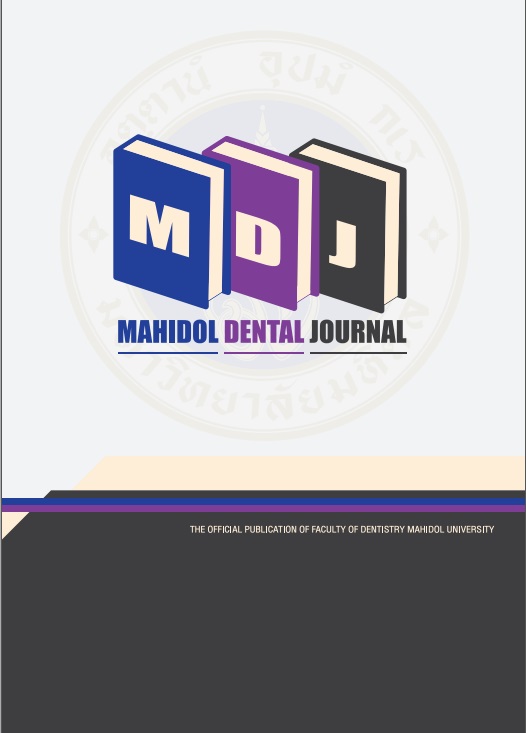Ergonomic working posture in dentistry: Importance of body and limb dimensions
Main Article Content
Abstract
Objective: The aim of this study was to demonstrate the importance of body and limb dimensions in maintaining an ergonomic working posture with provided equipment in a group of undergraduate dental students at Mahidol University.
Materials and methods: 75 undergraduate dental students participated in this study. The participants were directed to sit in the upright position. Leg and arm measurements were performed. The leg measurements were used to evaluate the appropriateness of the limb dimensions to the dimensions of the dental chair. The dimensions of the body and upper extremities were used to calculate the visual distance. Descriptive statistics were used to analyze the data.
Results: Forty-three percent of the participants had leg dimensions not suitable for maintaining an ergonomic working posture. The calculated visual distances of the participants were over the recommended values.
Conclusions: Inappropriate body and limb dimensions in a group of undergraduate dental students at Mahidol university is observed. This impedes students from maintaining an ergonomic working posture on the provided equipment. Performing physical activity during working hours and the use of additional equipment is recommended to reduce the risk of work-related musculoskeletal disorders
Article Details
References
Isper Garbin AJ, Barreto Soares G, Moreira Arcieri R, Adas Saliba Garbin C, Siqueira CE. Musculoskeletal disorders and perception of working conditions: A survey of Brazilian dentists in Sao Paulo. Int J Occup Med Environ Health 2017; 30: 367-77.
Phedy P, Gatam L. Prevalence and Associated Factors of Musculoskeletal Disorders among Young Dentists in Indonesia. Malays Orthop J 2016; 10: 1-5.
Yi J, Hu X, Yan B, Zheng W, Li Y, Zhao Z. High and specialty-related musculoskeletal disorders afflict dental professionals even since early training years. J Appl Oral Sci 2013; 21: 376-82.
El-Sallamy R, Atlam S, Kabbash I, El-Fatah S, El-Flaky A. Knowledge, attitude, and practice towards ergonomics among undergraduates of Faculty of Dentistry, Tanta University, Egypt. Environ Sci Pollut Res 2018; 25: 30793–801.
Rajeswari SR, Gowda TM, Kumar TA, Arya K, Mehta DS. Assessment of interns and postgraduate dental student's knowledge regarding equipment ergonomics. Indian J Dent Res. 2016; 27: 256-61.
Munaga S, Rawtiya M, Khan S, Chitumalla R, Kubagiri S, Sajjan P. Assessment of knowledge, practices, and work place condition related to ergonomics among dental students of Bhopal city - A questionnaire study. J Orofac Sci 2013; 5: 109-13.
Valachi B, Valachi K. Mechanisms leading to musculoskeletal disorders in dentistry. J Am Dent Assoc. 2003; 134: 1344-50.
Naqvi W, Kulkarni, Sumbh SJ. Mechanisms leading to work related Musculoskeletal Disorders in Dental Professions. Pravara Med Rev 2008; 3: 35-7.
Promprakai T, Rodanant P. Ergonomic risk assessment from working postures in fourth year undergraduate dental students at Mahidol University. M Dent J 2019; 39: 63-9.
Council on Dental Practice (CDC) An introduction to ergonomics: Risk Factors, MSDs, Approaches and Interventions. A report of the Ergonomics and Disability Support Advisory Committee (EDSAC). American Dental Association 2004. Available from http://rgpdental.com/pdfs/topics_ergonomics_paper(2).pdf.
Hokwerda O, Wouters JAJ, De Ruijter RAG, Zijlstra-Shaw S. Ergonomic requirements for dental equipment. Guidelines and recommendations for designing, constructing and selecting dental equipment. 2007: p.10, p.32.
Harrison DD, Harrison SO, Croft AC, Harrison DE, Troyanovich SJ. Sitting Biomechanics Part I: Review of the Literature. J Manipulative Physiol Ther 1999; 22: 594-609.
Anghel M, Argesanu V, Talpos-Niculescu C, Lungeanu D. Musculoskeletal disorders (MSDs) consequence of prolonged static posture. J Exp Med & Surg Res 2007; 14: 167-72.
Hokwerda O, Wouters J, Ruijter D, Zijlstra-Shaw S. Ergonomic requirements for dental equipment Guidelines and Recommendations for Designing, Constructing and Selecting Dental Equipment. 1st Update. Annual Meeting of the European Society of Dental Ergonomics in Bensheim, Germany; 2005. Available from: http://www.optergo.com/images/Ergonomic_req_april2007.pdf.
Hedge A. Introduction to Ergonomics: American Public Health Association; 1998.
Harshid PL, Menhul MR, Mihir R, Piyanka P. Prevalence and associated factors of back pain among dentists in South Gujarat. Nat J Med Res. 2012; 2: 229-31.
Kierklo A, Kobus A, Jaworska M, Botulinski B. Work related musculoskeletal disorder among dentists – a questionnaire survey. Ann Agric Environ Med. 2011; 18: 79-84.
Pope-Ford R, Jiang Z. Neck and shoulder muscle activation patterns among dentists during common dental procedures. Work 2015; 51: 391-9.
Chang BJ. Ergonomic benefits of surgical telescope systems: selection guidelines. J Calif Dent Assoc 2002; 30: 161-9.
Finkbeiner BL. Selecting equipment for the ergonomic four-handed dental practice. J Contemp Dent Pract 2001; 15: 44-52.
Gosavi SS, Gosavi SY, Jawade RS. Posturedontics: reducing the stress in dentistry. World J Dent 2012; 3: 335-9.
Kumar DK, Rathan N, Mohan S, Begum M, Prasad B, Prasad ER. Exercise prescription to prevent musculoskeletal disorders in dentists. J Clin Diagn Res 2014; 8: 13-6.
Khalekar Y, Zope A, Chaudhari L, Brahmankar U, Gadge H, Deore S. Prevention Is Better Than Cure: Ergonomics in Dentistry. JOADMS 2016; 2: 209-16.


